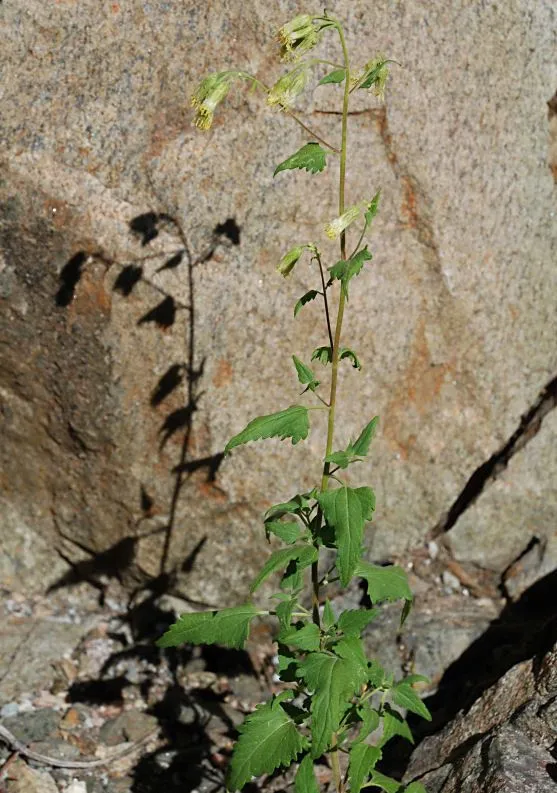
Author: (Hook.) Nutt.
Bibliography: Trans. Amer. Philos. Soc., ser. 2, 7: 287 (1840)
Year: 1840
Status: accepted
Rank: species
Genus: Brickellia
Vegetable: False
Observations: W. & C. U.S.A. to Mexico
Tasselflower brickellbush, scientifically known as Brickellia grandiflora, is a fascinating member of the Asteraceae family, known for its distinctive and ornamental tassel-like flowers. This resilient perennial herbaceous plant is native to the western and central regions of the United States and extends its range into Mexico, thriving in diverse habitats from grasslands to rocky terrains and open woodlands.
Characterized by its upright growth habit, Brickellia grandiflora typically reaches a height of around 2 to 4 feet. The plant boasts slender, branching stems that are often tinged with a reddish hue. Its foliage consists of lance-shaped, serrated leaves which are a vibrant green, providing a lush backdrop to its unique floral displays.
The most striking feature of the Tasselflower brickellbush is undoubtedly its flowers. Blooming from mid-summer to early fall, the small, tubular florets aggregate into dense, rounded clusters that resemble tassels, hence the common name. These flower clusters are predominantly a creamy white or pale yellow but can sometimes display subtle hints of pink or purple, adding to their aesthetic appeal. The flowers are not only visually appealing but also ecologically significant, attracting various pollinators such as bees, butterflies, and other insects, thus playing a crucial role in the local ecosystem.
Brickellia grandiflora was first described by botanists in the early 19th century, with its formal documentation appearing in the Transactions of the American Philosophical Society in 1840, attributed to the work of (Hook.) Nutt. This historical botanical recognition underscores the plant’s long-standing intrigue and study among plant enthusiasts and researchers.
For gardeners and landscape designers, the Tasselflower brickellbush is valued for its drought tolerance and low maintenance needs, making it an excellent choice for xeriscaping and native plant gardens. It prefers well-drained soil and full sun to partial shade, where it can flourish with minimal water once established.
By cultivating Brickellia grandiflora, not only does one enjoy the elegant beauty and delicate charm of its blossoms, but one also supports local biodiversity, contributing to more sustainable and ecologically integrated gardening practices.
Eng: tasselflower brickellbush, large-flowered brickellia, tasseled-flowered brickellbush
Fra: brickellie à grandes fleurs
En: Tasselflower brickellbush, TASSELFLOWER BRICKELLIA, Large-flowered brickellia, Tasseled-flowered brickellbush
Fr: Brickellie à grandes fleurs
Nv: Jaaʼabaní yiltʼąąʼí
Taken Oct 11, 2010 by EOL − Barry Breckling (cc-by-nc-sa)
Taken Oct 11, 2010 by EOL − Barry Breckling (cc-by-nc-sa)
Taken May 15, 2011 by EOL − Barry Breckling (cc-by-nc-sa)
Taken Jun 7, 2000 by EOL − Charles Webber (cc-by-nc-sa)
Taken Feb 28, 2016 by EOL − Robb Hannawacker (cc-by-nc)
Taken May 15, 2011 by EOL − Barry Breckling (cc-by-nc-sa)
© copyright of the Board of Trustees of the Royal Botanic Gardens, Kew.
Growth habit>: Subshrub, Forb/herb
Family: Myrtaceae Author: (F.Muell.) K.D.Hill & L.A.S.Johnson Bibliography: Telopea 6: 402 (1995) Year: 1995 Status:…
Family: Rubiaceae Author: Pierre ex A.Froehner Bibliography: Notizbl. Bot. Gart. Berlin-Dahlem 1: 237 (1897) Year:…
Family: Sapindaceae Author: Koidz. Bibliography: J. Coll. Sci. Imp. Univ. Tokyo 32(1): 38 (1911) Year:…
Family: Asteraceae Author: A.Gray Bibliography: Pacif. Railr. Rep.: 107 (1857) Year: 1857 Status: accepted Rank:…
Family: Fabaceae Author: Medik. Bibliography: Vorles. Churpfälz. Phys.-Ökon. Ges. 2: 398 (1787) Year: 1787 Status:…
Family: Aspleniaceae Author: (Cav.) Alston Bibliography: Bull. Misc. Inform. Kew 1932: 309 (1932) Year: 1932…